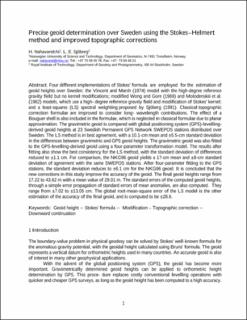| dc.contributor.author | Nahavandchi, Hossein | |
| dc.contributor.author | Sjöberg, Lars Erik | |
| dc.date.accessioned | 2023-08-11T07:38:09Z | |
| dc.date.available | 2023-08-11T07:38:09Z | |
| dc.date.created | 2002-01-10T00:00:00Z | |
| dc.date.issued | 2001 | |
| dc.identifier.citation | Journal of Geodesy. 2001, 75 (2-3), 74-88. | en_US |
| dc.identifier.issn | 0949-7714 | |
| dc.identifier.uri | https://hdl.handle.net/11250/3083471 | |
| dc.description.abstract | Four different implementations of Stokes's formula are employed for the estimation of geoid heights over Sweden: the Vincent and Marsh (1974) model with the high-degree reference gravity field but no kernel modifications; modified Wong and Gore (1969) and Molodenskii et al. (1962) models, which use a high-degree reference gravity field and modification of Stokes's kernel; and a least-squares (LS) spectral weighting proposed by Sjoberg (1991). Classical topographic correction formulae are improved to consider long-wavelength contributions. The effect of a Bouguer shell is also included in the formulae, which is neglected in classical formulas due to planar approximation. The gravimetric geoid is compared with global positioning system (GPS)-levelling-derived geoid heights at 23 Swedish Permanent GPS Network SWEPOS stations distributed over Sweden. The LS method is in best agreement, with a 10.1-cm mean and 5.5-cm standard deviation in the differences between gravimetric and GPS geoid heights. The gravimetric geoid was also fitted to the GPS-levelling-derived geoid using a four-parameter transformation model. The results after fitting also show the best consistency for the LS method, with the standard deviation of differences reduced to 1.1 cm. For comparison, the NKG96 geoid yields a 17-cm mean and 8-cm standard deviation of agreement with the same SWEPOS stations. After four-parameter fitting to the GPS stations, the standard deviation reduces to 6.1 cm for the NKG96 geoid. It is concluded that the new corrections in this study improve the accuracy of the geoid. The final geoid heights range from 17.22 to 43.62 m with a mean value of 29.01 m. The standard errors of the computed geoid heights, through a simple error propagation of standard errors of mean anomalies, are also computed. They range from 7.02 to 13.05 cm. The global root mean square error of the LS model is the other estimation of the accuracy of the final geoid, and is computed to 28.6 cm. | en_US |
| dc.language.iso | eng | en_US |
| dc.publisher | Springer | en_US |
| dc.title | Precise geoid determination over Sweden using the Stokes-Helmert method and improved topographic corrections | en_US |
| dc.title.alternative | Precise geoid determination over Sweden using the Stokes-Helmert method and improved topographic corrections | en_US |
| dc.type | Peer reviewed | en_US |
| dc.type | Journal article | en_US |
| dc.description.version | acceptedVersion | en_US |
| dc.source.pagenumber | 74-88 | en_US |
| dc.source.volume | 75 | en_US |
| dc.source.journal | Journal of Geodesy | en_US |
| dc.source.issue | 2-3 | en_US |
| dc.identifier.doi | https://doi.org/10.1007/s001900000154 | |
| dc.identifier.cristin | 409110 | |
| cristin.ispublished | true | |
| cristin.fulltext | postprint | |
| cristin.fulltext | postprint | |
| cristin.qualitycode | 1 | |
